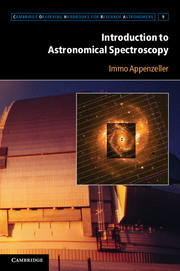Book contents
- Frontmatter
- Contents
- Preface
- 1 Historical Remarks
- 2 Spectroscopy in Present-Day Astronomy
- 3 Basic Physics of Spectral Measurements
- 4 Optical-Range Grating and Prism Spectrometers
- 5 Other Techniques for the Optical Spectral Range
- 6 Preparing and Reducing Optical Observations
- 7 UV, X-Ray, and Gamma Spectroscopy
- 8 Spectroscopy at Radio Wavelengths
- 9 Special Techniques of the FIR and Submillimeter Range
- 10 New Developments and Future Prospects
- Appendix: List of Acronyms
- References
- Index
Preface
Published online by Cambridge University Press: 05 January 2013
- Frontmatter
- Contents
- Preface
- 1 Historical Remarks
- 2 Spectroscopy in Present-Day Astronomy
- 3 Basic Physics of Spectral Measurements
- 4 Optical-Range Grating and Prism Spectrometers
- 5 Other Techniques for the Optical Spectral Range
- 6 Preparing and Reducing Optical Observations
- 7 UV, X-Ray, and Gamma Spectroscopy
- 8 Spectroscopy at Radio Wavelengths
- 9 Special Techniques of the FIR and Submillimeter Range
- 10 New Developments and Future Prospects
- Appendix: List of Acronyms
- References
- Index
Summary
With the exception of a few objects that have been successfully identified as sources of highly energetic charged particles or of neutrinos, all our knowledge about the universe outside the inner solar system is based on the analysis of electromagnetic radiation. Some valuable information has been derived by measuring the flux, the time variations, or the polarization of astronomical radiation sources. By far the most important tool for investigating cosmic objects, however, has been the analysis of their energy distributions and of their line spectra. There are obvious reasons for this predominance of spectroscopic methods in modern astronomy. First, spectra contain a particularly large amount of physical information. If properly analyzed, spectra allow us to determine the chemical composition, local physical conditions, kinematics, and presence and strength of local physical fields. Second, apart from the cosmological redshift and the reduced observed total flux of faraway objects, spectra are independent of the distance, making spectroscopy a particularly valuable remote-sensing tool. Finally, there exists a well-developed theory of the formation of continua and line spectra.
The gathering of information on distant objects by means of spectral observations requires several steps. First, suitable instruments must be designed that allow us to measure the spectra of the faint astronomical sources. Then, these instruments must be employed to obtain spectra of optimal quality. Finally, the spectra must be analyzed and physical information on the observed objects must be extracted.
- Type
- Chapter
- Information
- Introduction to Astronomical Spectroscopy , pp. xi - xivPublisher: Cambridge University PressPrint publication year: 2012



